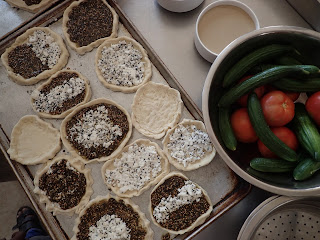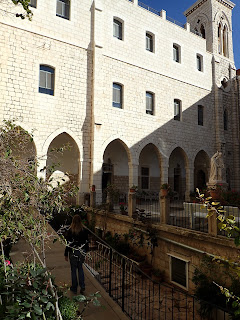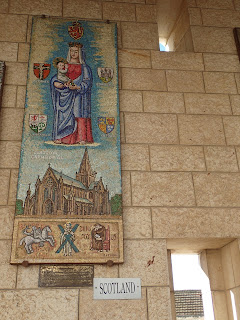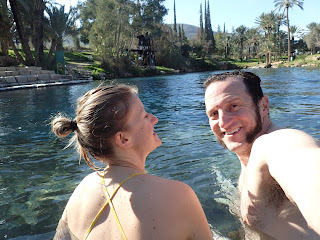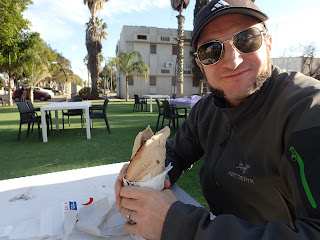Thanks to the Jerusalem Marathon closing the main streets, the Consulate was closed on Friday and we had a nice 3-day weekend. Where to go? “Let’s go to Jordan!”
Feynan Ecolodge
Our friend, we’ll call her Sunny-D, suggested the Feynan Ecolodge in the Dana Biosphere Reserve for a long weekend of hiking in the Jordan desert. While a bit pricey (the room rates are about $140 per person per night), the lodge included everything from meals to hikes to stargazing to cooking classes, so we figured it would be worth it.
Feynan is 20km off the main road, located in a remote wadi. When the dirt road is in bad shape, they shuttle their guests in by 4x4 pickup truck. It is totally off the grid with solar panels for a little electricity, no outlets in the rooms, and solar water heaters for hot water in the afternoon (cold in the morning). At sunset the staff lights up the entire lodge with candles and stokes a nice fire in the main lounge burning compressed logs of olive pits made from the leftovers of the olive oil making process in other parts of Jordan. The lodge is this beautiful cream-colored adobe building that blends in with the surrounding desert.
Local touches like goat-skin lanterns, clay jars instead of plastic bottles for water in the rooms, and mosquito nets over the beds make the lodge more than just a nice hotel. Men from the local Bedouin tribe run the lodge including cooking the meals, cleaning the rooms and leading the hikes. The lodge was built with funding and ecotourism expertise from USAID and now all the money earned stays in the local community. There is an open rooftop for stargazing (also perfect for sunset Yoga), a lovely patio surrounded by native jojoba trees, and just a stone’s throw away are the goat hair Bedouin tents of tribes that have been living in this wadi for hundreds (thousands?) of years.
So, it didn’t take much convincing... on Friday morning our group of 7 friends drove across the border at the Allenby Bridge and continued on the 4-hour drive southeast along the shores of the Dead Sea to Jordan’s largest park.
Day 1: Crossing at Allenby/King Hussein Bridge
We were a little nervous crossing the border with our own car for the first time. While we had flown through Jordan and spent the night in Amman multiple times while stationed in Baghdad, this would be our first land crossing. Mixed reports of “the easiest thing ever, you don’t need a visa” to “it took us 3 hours and you can’t cross without insurance and a visa” left us uneasy, but we prefered to try the Allenby crossing which gave us a shorter drive than to go for the “way easier” crossing down at Eilat which would have meant a 6-hour drive. The border crossing was easier than we anticipated and we were through it in a little over an hour. We had to buy a month of expensive Jordanian car insurance through email ahead of time since they don’t offer insurance at this border crossing anymore, but we split the $120 cost between the 3 of us in our car which made it not so painful.
While we had to visit 4 windows to get through the process on the Israeli side, the crossing station was large, clean, organized and friendlier than some service in Jerusalem. The Jordanian side was faster (only 3 windows) and a bit more wild west but we made it through and no one ever asked to see our $120 proof of insurance...
The drive was easy. The road did have potholes, unmarked speed bumps and goats, but was not as bad as some had described. I suppose Jordan is still “Middle East Light.” We enjoyed expansive Dead Sea views and stopped for a grilled chicken lunch in a little town along the way. The last part of the drive was on a dirt road which our little red Renault handled like a champ. We arrived at Feynan just in time to check in, change, and join the sunset hike. Our guide Suleiman lit a campfire while we snapped some sunset photos and hiked around. Sipping extremely sweet black tea flavored with a native desert herb, he told us stories about this wadi where he was born, raised and is now able to work and guide visitors. Including stories of wolves eating 3 goats just the other day, white desert cats that were thought to be gone from the area but were captured with motion sensor cameras recently and scorpions that the Bedouin mothers roast over the fire, grind up, and put on their nipples to give their babies resistance to the venom.
Back at the lodge, dinner by candlelight was a buffet feast of vegetarian salads, roasted veggies, pickles, bread and cheese. We enjoyed after-dinner tea in front of the fire, a presentation on the history of the lodge and guided stargazing on the roof. Then it was off to our cozy, dark little rooms with the sounds of crickets and Bedouin voices in the distance drifting in through the windows for a very peaceful snooze.
Day 2: #ILoveTheForeignService
We awoke around 7am for an amazing breakfast buffet of hard boiled eggs, dates, cheese, labneh, bread, cream and honey. With coffee of course, that the chef was very excited to say was “American Coffee” which it was, kind of, in that it had a little less mud than usual. They gave us sack lunches and our shepherd for the day met us at the front door. Ahmed was 20 years old and had a job at a nearby airport during the week, but what he really loved was making a little extra money on his days off shepherding his neighbor's herd of 100 goats on their daily foraging excursion.
These goats hiked our butts off! We hiked straight uphill at first, always about 100 meters behind the herd, feeling like we were almost caught up, but then as we crested one hill we’d see their shaggy shapes in the distance passing over the next hill. This was our day: Shadowing a Bedouin Goat Herder.
Once we got up high into the mountains where there was an abundance of the goats’ favorite flowers, their pace slowed a little. We stopped frequently for tea heated over a fire, sometimes with fresh goat milk sometimes with just sugar. Ahmed used his limited English and we used our even more limited Arabic to ask him questions about the goats, his life, his family and this desert.
“How do you say goat in Arabic?”
“Ganam.”
“Do you ever sing out here?”
“Yes, when I am alone.”
We loved every second of it and agreed that we were awed by Ahmed’s athletic ability to run over the loose, rocky terrain that we had to pick our way through, and his unique ability to communicate with his goats using an individual call (which sounded like a bark) to tell his goats where he wanted them to go... or at least he pretended like they were listening and they were going where he wanted them to go... or were the goats herding us?
We had 2 donkey friends that came with us. While we were never able to get close enough to the goats to play with them, the donkeys stayed with us and made great trail blazers.
“Go behind the donkey, he finds the easy way.”
“This is the easy way?!”
Sweet donkeys, carrying our water and snacks, with no names other than Young Donkey and Old Donkey, slaves to their Bedouin masters, but they still seemed to enjoy the petting and scratching we gave them during tea breaks.
Near the end of the day we met up with another large herd of goats and their goatherd who was carrying a baby goat that had just been born that day, so young it still had the wet umbilical cord hanging off its belly. It could already stand but wasn’t strong enough to walk yet so the shepherd carried it with Mama Goat trailing behind following the bleats of its baby. The shepherd would stop every 10 minutes to let her eat while the baby tried its best to figure out how to nurse, her little tail a happy wagging blur.
We were dusty, dehydrated, and tired when the goats finally returned us to the lodge in late afternoon, but nothing sounded better than a mellow sunset Yoga session to stretch our stiffening legs. The breeze was warm blowing off the sun-heated rocks in the distance and the last light of the day bathed us in the most perfect glow as we breathed in the dry, clean air and stretched to the sounds of the Bedouins nearby peacefully preparing for night to fall and putting their goats to bed in the corals to keep them safe from the wolves.
Day 3: Wormwood and Falafels in the Desert
After a chilly shower and a simple yet amazing breakfast we suited up for a morning hike. Suleiman was our guide again for the 3-hour Plant Hike. He pointed out the thorny jojoba trees growing nearby with their edible little dry fruits and also the rare desert moringa trees that are good for nutrition. We stopped to brew tea with artemisia in it and learned that is is also known as wormwood and related to mugwort. He showed us a plant that when pounded on a rock and mixed with water forms a sudsy paste for cleaning. Many of the plants growing around here are useful to the Bedouins as healing herbs, building materials and food for their goats. The preparation for almost all of the plants was the same: you boil it and drink it or shower the baby in it.
Suleiman shared with us his hopes to be able to get a visa someday to visit all the friends from different countries he has met who come Feynan. He said he is happiest here in the desert with his tribe and couldn’t imagine living anywhere else, especially in a big noisy city, but that meeting so many people from other places makes him curious to explore. Sitting on a rock drinking tea with him in that quiet, clean, beautiful setting, we believed him, but what consular officer in Amman ever would? Maybe he’ll get a visa to travel someday, but in the meantime we told him that while the rest of the world is interesting, he is very lucky to live where he does. He believed us, I think.
This whole weekend we didn’t see any Bedouin women, we assumed they were here, just hidden away from the eyes of strangers in their dark, smokey little tents. Ali, the manager of the lodge told us that if it was just women going on the goat hike then our shepherd would have been a female shepherdess. Suleiman shared that some believe if a Bedouin woman is not bearing children, you need to make her jealous, then she will get pregnant. We also learned a favorite Bedouin saying, “A woman is like a teabag, you don’t know how strong she is until you put her in boiling water.” I looked at the women around me sipping tea with their faces, arms, ankles and hair exposed to the sun. How lucky we were to be born into the life that we were, in this place and time.
The Feynan chef makes amazing food, but he doesn’t speak English well, so Suleiman translated while he instructed. We made fresh baked flatbread with za’atar and cheese, salad with tahina and fresh falafel balls. We stuffed ourselves on the sunny patio, enjoying this last moment and commenting how the weekend felt longer than just 2 nights, it was so packed with fun.
We said farewell to our hosts and made the journey home to Jerusalem. Home to the big city, looking forward to returning to our apartments but wishing just a little that our home was a tent in the desert with no electricity, wifi or traffic, and our job was to wake up the next day and follow our goats out into the desert to forage. I can’t say the same for our travel companions, but Hubby and I can’t wait to get our camping mojo back soon.





















